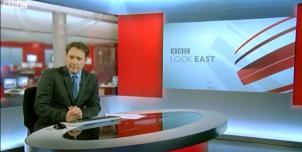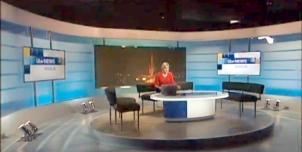Full Freeview on the Sandy Heath (Central Bedfordshire, England) transmitter
| Google Streetview | Google map | Bing map | Google Earth | 52.130,-0.242 or 52°7'47"N 0°14'33"W | SG19 2NH |
The symbol shows the location of the Sandy Heath (Central Bedfordshire, England) transmitter which serves 920,000 homes. The bright green areas shown where the signal from this transmitter is strong, dark green areas are poorer signals. Those parts shown in yellow may have interference on the same frequency from other masts.
This transmitter has no current reported problems
The BBC and Digital UK report there are no faults or engineering work on the Sandy Heath (Central Bedfordshire, England) transmitter._______
Digital television services are broadcast on a multiplexes (or Mux) where many stations occupy a single broadcast frequency, as shown below.
64QAM 8K 3/4 27.1Mb/s DVB-T MPEG2
H/V: aerial position (horizontal or vertical)
Which Freeview channels does the Sandy Heath transmitter broadcast?
If you have any kind of Freeview fault, follow this Freeview reset procedure first.Digital television services are broadcast on a multiplexes (or Mux) where many stations occupy a single broadcast frequency, as shown below.
64QAM 8K 3/4 27.1Mb/s DVB-T MPEG2
H/V: aerial position (horizontal or vertical)
Which BBC and ITV regional news can I watch from the Sandy Heath transmitter?

BBC Look East (West) 1.0m homes 3.7%
from Cambridge CB4 0WZ, 29km east-northeast (65°)
to BBC Cambridge region - 4 masts.
70% of BBC East (East) and BBC East (West) is shared output

ITV Anglia News 1.0m homes 3.7%
from Norwich NR1 3JG, 119km east-northeast (60°)
to ITV Anglia (West) region - 5 masts.
All of lunch, weekend and 80% evening news is shared with Anglia (East)
How will the Sandy Heath (Central Bedfordshire, England) transmission frequencies change over time?
| 1965-80s | 1984-97 | 1997-98 | 1998-2011 | 2011-13 | 12 Feb 2020 | ||||
| VHF | A K T | K T | K T | W T | W T | ||||
| C6 | ITVwaves | ||||||||
| C21 | C4waves | C4waves | C4waves | +BBCB | BBCB | ||||
| C24 | ITVwaves | ITVwaves | ITVwaves | D3+4 | D3+4 | ||||
| C27 | BBC2waves | BBC2waves | BBC2waves | BBCA | BBCA | ||||
| C31 | BBC1waves | BBC1waves | BBC1waves | ||||||
| C32 | com7 | ||||||||
| C33 | SDN | ||||||||
| C34 | com8 | ||||||||
| C35 | _local | ||||||||
| C36 | ArqA | ||||||||
| C39 | C5waves | C5waves | |||||||
| C43 | _local | ||||||||
| C48 | ArqB | ArqB | |||||||
| C51tv_off | SDN | ||||||||
| C52tv_off | ArqA | ||||||||
| C55tv_off | com7tv_off | ||||||||
| C56tv_off | COM8tv_off |
tv_off Being removed from Freeview (for 5G use) after November 2020 / June 2022 - more
Table shows multiplexes names see this article;
green background for transmission frequencies
Notes: + and - denote 166kHz offset; aerial group are shown as A B C/D E K W T
waves denotes analogue; digital switchover was 30 Mar 11 and 13 Apr 11.
How do the old analogue and currrent digital signal levels compare?
| Analogue 1-4 | 1000kW | |
| BBCA, D3+4, BBCB | (-7.4dB) 180kW | |
| SDN, ARQA, ARQB | (-7.7dB) 170kW | |
| com7 | (-13dB) 49.6kW | |
| com8 | (-13.1dB) 49.1kW | |
| Mux 1*, Mux 2*, Mux A*, Mux B*, Mux C*, Mux D* | (-17dB) 20kW | |
| Analogue 5 | (-20dB) 10kW |
Which companies have run the Channel 3 services in the Sandy Heath transmitter area
|
|
Wednesday, 17 December 2025
C
Chris.SE11:37 PM
Andrew:
Just to add the aerial rods (or squashed Xs) should be horizontal polarisation.
| link to this comment |
Select more comments
Your comment please!




